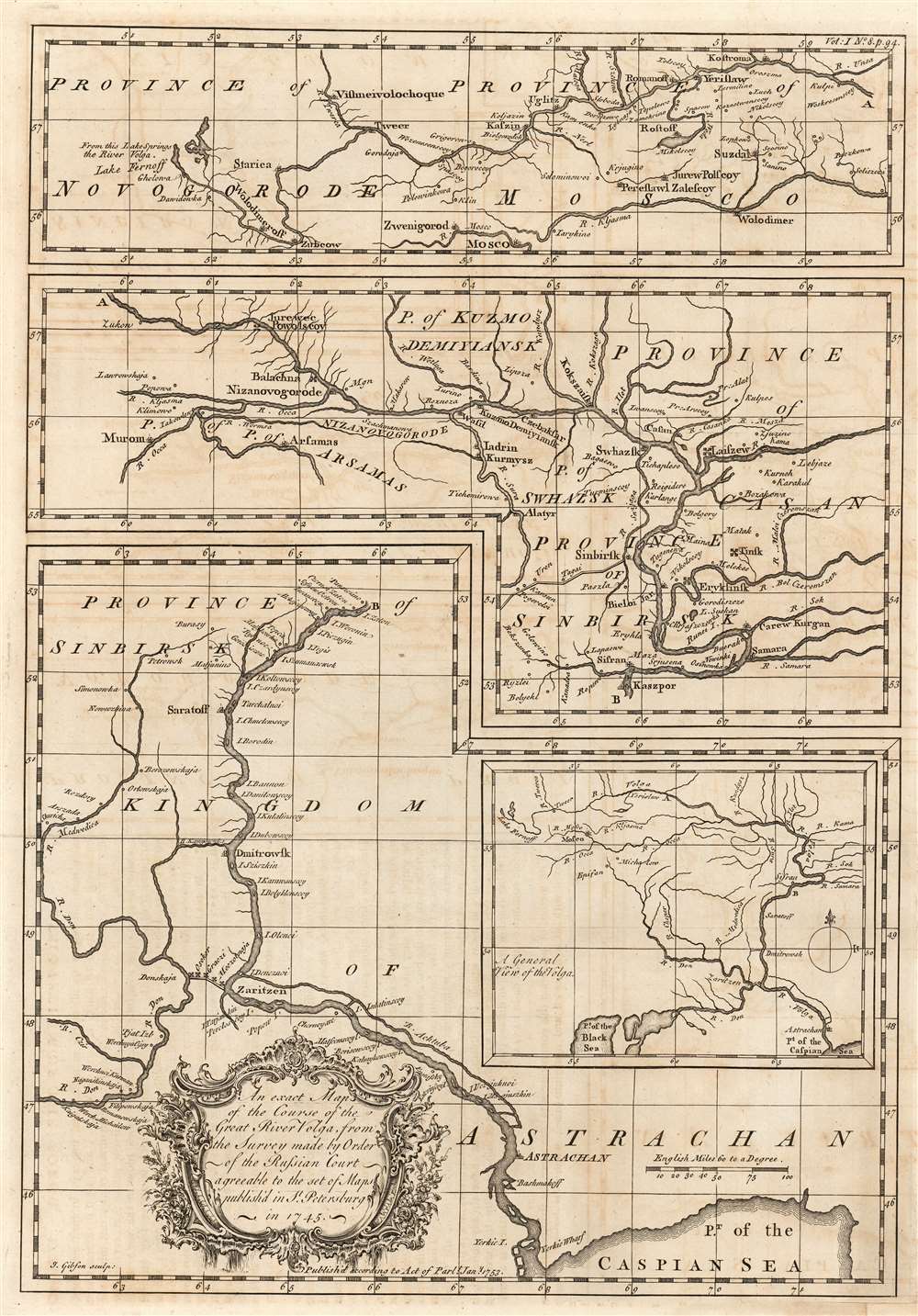1753 Jonas Hanway Map of the Volga River, Russia
Volga-gibson-1753
Title
1753 (dated) 15 x 10.5 in (38.1 x 26.67 cm) 1 : 3800000
Description
Joining the Don and Volga Rivers
One fascinating detail is the clear depiction of the Don-Volga Portage and its forts, pictured connecting the River Don and the River Volga at those rivers' nearest navigable point near Tsaritsyn (Volgograd / Stalingrad). The significance of this route extends through history: settlements along the Don-Volga Portage go back more than 2400 years. The Ottoman Empire may have attempted a canal there as early as the sixteenth century, although that project was abandoned. Eventually the region fell within the borders of the expanding Russian Empire, and Peter the Great made efforts to connecting the two rivers. Abortive attempts at canalizing the portage began as early as 1696 following the Russian capture of Azov, but were abandoned following the 1711 return of that fortress to the Ottomans. Railways were be built along the Portage in the 19th century but a modern canal linking the Don and the Volga was not be completed until 1952. Peter the Great's attempt to connect the upper Don and Volga far upriver at Yepifan were impractical due to the shallowness of the rivers. (The city, spelled Epifan, appears at the uppermost reach of the Don on the 'general' inset but is too remote to be included in any of the main maps.) The Petrov Val canal between the Don and Volga tributaries Ilovlya and Kamyshinka, operated with some success from 1702 until its abandonment in 1709. It is shown here (as the Kamyshinka River) emptying into the Volga near Dmitrowsk (Kamyshin).Publication History and Census
The chart was engraved by John Gibson in 1753 for inclusion in Jonas Hanway's An Historical Account of the British Trade over the Caspian Sea. We are aware of three editions of the work, this example appeared in the third. We see eight examples of the complete work in institutional collections. We see only one example of this map catalogued in OCLC, at the National Library of Scotland.CartographerS
Jonas Hanway (August 12, 1712 - September 5, 1786), was an English philanthropist, traveller, and writer. He was apprenticed in 1729 to a merchant in Lisbon, but in 1743 he became partner to merchant and member of the British Russia Company Robert Dingley (1710 - 1780) who was based in St. Petersburg. This led to the travels in Russia, Central Asia, and Persia which would inform Hanway's (copious) writing on the topic of British trade in the Caspian Sea, which would earn him the attentions of scholar Charles Wilson who hailed him 'one of the most indefatigable and splendid bores of English history.' On his return to London his narrative brought him some fame and success, and thereafter he remained in the city devoted to good causes and good citizenship. He founded The Marine Society in 1756 (a charity supporting inland youths wishing to go to sea.) He was instrumental in the aid of various hospitals; arranged improvements in Londons's birth registration system; and in 1762 he was appointed a commissioner for victualling the navy. Hanway was an eccentric and a gadfly. He protested, voluminously, the English practice of tea drinking, both on the grounds of its effect on the health and on the balance of foreign trade. He was the first male Londoner to carry an umbrella. This shocking move drew the opprobrium of fellow Londoners who objected to the effeminate, French contraption, and the ire of hansom cab drivers who quite correctly identified the invention as a threat to their trade (rainstorms caused Londoners to flock to hansom cabs as a sheltered means of transport.) He died unmarried. A monument to his memory stands in Westminster Abbey, praising his works of charity. It discusses neither umbrellas nor tea. More by this mapmaker...
John Gibson (1724 – 1773) was an English map engraver active in London at the end of the 18th century. Gibson was the son of a locksmith. In 1739 he apprenticed to John Blundell as a stationer of Grub Street. Gibson proved a fine engraver and was much in demand by London map publishers. During his career he produced thousands of maps and was admired as a skilled engraver and sculptor. Among others, he engraved for Emanuel Bowen, Robert Sayer, Jean Palairet, John Rocque, Andrew Dury, and Benjamin Martin. His best known work was prepared in conjunction with Gentleman's Magazine. Gibson, sadly, was not as astute in his fiscal affairs as with the engravers pen and consequently spent much of his life consigned to debtor's prison. Learn More...

